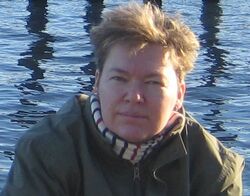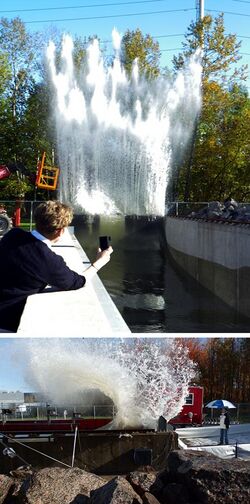Biography:Jannette B. Frandsen
Jannette B. Frandsen | |
|---|---|
 | |
| Alma mater | Technical University of Denmark Imperial College University of Cambridge Peterhouse |
| Awards | US National Science Foundation CAREER Award; Université du Québec - Institut national de la recherche scientifique: Chair of Coastal & River Engineering |
| Scientific career | |
| Fields | Fluid mechanics Water waves Aerodynamics Fluid-structure interaction Structural mechanics Vibrations |
| Institutions | Fluid Structure Systems |
Jannette Behrndtz Frandsen is a researcher and consultant who works in many fields including nearshore hydrodynamics, aeroelasticity, numerical analysis, computational fluid dynamics, coastal modeling, experimental fluid mechanics, sloshing, coastal erosion, effects of climate change , e.g., sea level rise, natural hazards (storms, tsunamis), wind energy, biomimetics, wave energy.
The common theme of her fundamental research includes investigations of free-surface gravity water waves and bluff-body boundary layer physics. Combining fluid dynamics and elasticity is one goal of the research but the understanding and the predictions of the fluid dynamics itself tend to represent the main challenges. The moving boundary treatment and bubbly fluid flow behavior in high Reynolds number and Froude number flows are the primary questions to address. Driven by contributing to the understanding of the underlying physics of turbulence and wave breaking, Prof. Frandsen investigates the suitability of numerical approaches spanning a wide range of length scales from micro to macroscopic flow structures in highly nonlinear flows. The continuum- and mesoscopic approaches explored include discretization of fully non-linear free-surface potential flow -, Navier-Stokes - and Lattice Boltzmann equations (LBE). Her early work on water wave mechanics was carried out in the Department of Engineering Science, University of Oxford where she held a departmental lecturership concurrently with her research fellowship at Oriel College. Later, she has earned worldwide practical, educational and research experiences. Among other contributions, she has developed and shown that nonlinear water waves can be captured accurately using various approaches rooted in the LBE.[1][2] Frandsen has further contributed to the understanding of free-surface dynamics via physical tank experiments and numerical modeling of e.g., slosh dynamics.[3][4] In recent years, she has conducted large scale wave flume experiments with application to coastal protection working on the understanding of the underlying mechanism of wave breaking and wave impact processes.

To investigate the physics of aeroelastic phenomena, she has measured and modeled[5] the coupling effects between fluid flow and elastically suspended bodies undergoing large movement in high Reynolds number. Fluid flow interaction with large structures often lead to resonance problems known as Vortex-induced vibrations, as represented in the first full-scale records on a long-span suspension bridge.[6] Prof. Frandsen has been involved in solving many vibration problems including the development of coupled solvers between fluid and structure, e.g., using tuned liquid dampers to suppress wind induced oscillations.[7]
Underpinning her academic experience, she has analysed and designed Offshore Oil and Gas Installations in seas worldwide estimating forces of ocean waves, buckling resistance, etc. She has also been engaged in offshore wind power and wave energy farm developments with a focus on establishing meteorological and oceanographic conditions in relation to design basis, amongst others. She has estimated wind load on many structures including tall buildings, suspension bridges, topsides on offshore platforms, solar plants, etc. Subsequently she has set-up physical models and field experiments, analysed and assessed the structural dynamics and provided solutions to Vortex-induced vibration (e.g., Great Belt East Bridge) and earthquakes.
Education
Frandsen received her basic education at Det Kongelige Vajsenhus the school of the Royal Orphanage (1975–83) – in Danish: Det Kongelige Vajsenhus. The school was founded in 1727 and its protector is Queen Margrethe II of Denmark. It was during these early school years she developed an interest for civil engineering. In 1991, Frandsen received her B.Sc. in civil engineering from The Technical University of Denmark. Spending some years in industry, she then continued her education at Imperial College London to get her M.Sc. in civil engineering with specialization in steel structures in 1996. Later, she received her Ph.D. in aeroelasticity from Cambridge University Engineering Department, Peterhouse, 2000.
References
- ↑ Liu, Philip L.-F.; Yeh, Harry; Synolakis, Costas (Eds.) (2008), "Advanced numerical models for simulating tsunami waves and runup", Advances in Coastal and Ocean Engineering (World Scientific) 10, doi:10.1142/9789812790910_0005, ISBN 978-981-270-012-4
- ↑ Frandsen, Jannette B. (2008), "A simple LBE wave run-up model", Progress in Computational Fluid Dynamics 8 (1-4): 222–232, doi:10.1504/PCFD.2008.018093
- ↑ Faltinsen, Odd M.; Timokha, Alexander N. (2009). Sloshing. Cambridge University Press. ISBN 0-521-88111-0.
- ↑ Frandsen, Jannette B. (2004), "Sloshing motions in excited tanks", Journal of Computational Physics 196 (1): 53–87, doi:10.1016/j.jcp.2003.10.031
- ↑ Frandsen, Jannette B. (2004), "Numerical bridge deck studies using finite elements", Journal of Fluids and Structures 19 (2): 171–191, doi:10.1016/j.jfluidstructs.2003.12.005
- ↑ Frandsen, Jannette B. (2001), "Simultaneous pressures and accelerations measured full-scale on the Great Belt East suspension bridge", Journal of Wind Engineering and Industrial Aerodynamics 89 (1): 95–129, doi:10.1016/S0167-6105(00)00059-3
- ↑ Frandsen, Jannette B. (2005), "Numerical predictions of tuned liquid tank structural systems", Journal of Fluids and Structures 20 (3): 309–329, doi:10.1016/j.jfluidstructs.2004.10.003
External links


